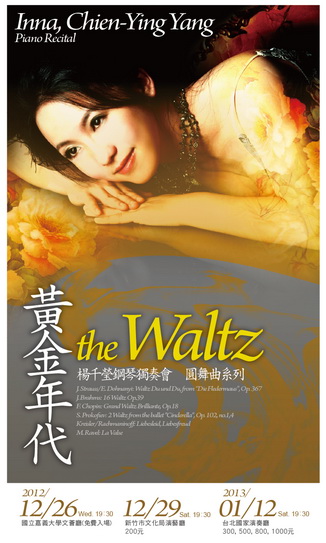:::
|
|
|
|
  News
News |
Create Date:2012-12-26
Update Date:2012-12-26
Bracket:
Department:Department of Food Science
|
Inna Chien-Ying Yang Piano Recital – the Waltz on December 26th
Inna Chien-Ying Yang Piano Recital – the Waltz on December 26th 
Yang Chien-Ying, assistant professor of NCYU’s Department of Music and student of a legendary Russian pianist, will be performing in her piano recital, “the Waltz” at Wen-hui Concert Hall of Minhsiung campus at 7 PM of December 26 2012. The piano recital will bring the audience back to the old times with reminiscent tunes. Any individuals interested in arts are welcome to attend the event.
Waltz originates from the country dance Ländler in Bohemia region. At 18th century, the dance became popular among aristocrats and spread from countryside to suburbs of the city. It has transformed into a trend and an indication of elegance and status, disseminating from Vienna to Paris, Barcelona, London and many other cities. With a simple rhythm and graceful movement, waltz becomes a classic dance suitable for both refined and popular tastes.
As time waltzed by, the feudalism in Europe stepped into sunset. The republic, constitution and parliament took over and rapidly changed the society. The eclecticism rose in 1867 and led to the birth of the Austro-Hungarian empire, which initiated the so-called golden era. However, skirmishes due to the conflict of interests in southeast Europe got out of control and eventually led to World War I. The Empire dissolved as a result and took the golden era with it. As a symbol for the golden era, waltz witnessed the rise and fall of Austria, or even the whole Europe.
Attempting to express the rise and fall with waltz, Yang has acquired skills to perform waltz’s different styles of various countries and different times. Yang will be presenting the classics of Waltz in the first half of the recital, such as Waltz Du und Du from “Die Fledermaus” by J. Strauss /E. Dohnanyi; and the popular Grand Waltz Brilliante, Op.18 by F. Chopin. For the second half of the recital, Yang will play the waltz in 20th century, including Liebesleid, Liebesfreud by F. Kreisler/S. Rachmaninoff, a waltz both reminiscent and avant-garde. The last performance is La Valse by Ravel, who wrote the piece after World War I ended. The masterpiece is said to allude to the birth and destruction of waltz after the Great War with its restless rhythm.
The piano recital debuted on the 26th will give a whole different experience to the audience, with the operette “Die Fledermaus” by J. Strauss recreating the late 19th century’s Europe, a rich, liberal golden era percolating with knowledge and arts. Yang will also perform at Concert Hall of Cultural Affairs Bureau, Hsinchu City at 7:30 PM, December 29, 2012, and at National Recital Hall at 7:30 PM, January 12, 2013.

 |
|
 |
 |
|